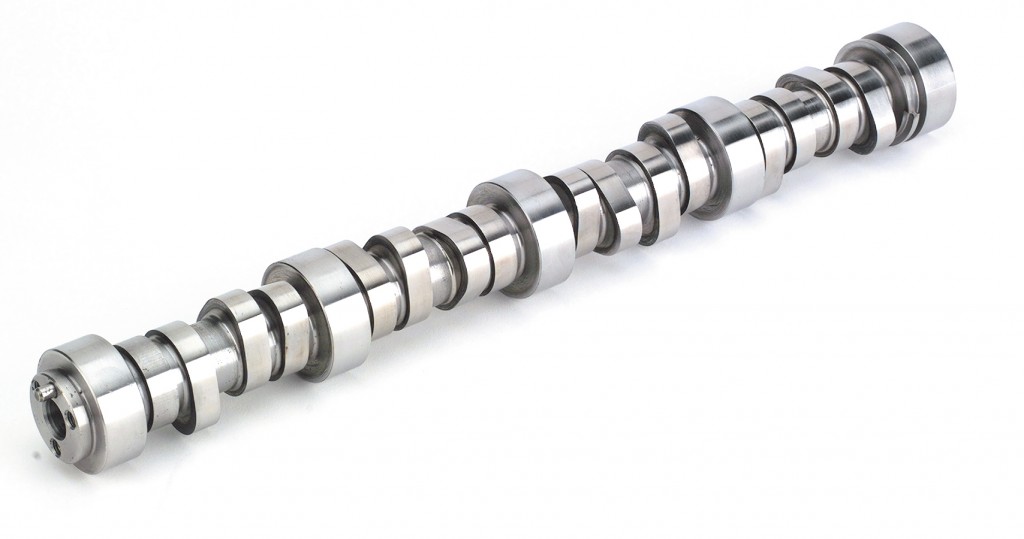Find the camshafts section in your latest Summit Racing catalog and you’ll quickly notice that all the cams are displayed with duration and lift. That’s because veteran gearheads use these key specs to help identify the right cam grind for their engine and application.
But there are other, lesser-known specifications you should be aware of when making a camshaft purchase, too.
In this post, we’re going beyond the typical catalog page description to cover things like lobe separation and intake centerline. According to the Summit Racing tech department, these oft-misunderstood specifications create some of the most frequently asked questions about camshafts:
What is camshaft lobe separation and how does it affect the engine?
Lobe separation, or lobe separation angle, is the distance (in camshaft degrees) that the intake and exhaust lobe centerlines are spread apart. This separation determines where peak torque will occur within the engine’s power range and also has an effect on idle quality and engine vacuum.
Tight lobe separations (under 112 degrees) cause the peak torque to build early in the rpm range and foster good acceleration. Broader lobe separations, 112-116 degrees, allows torque to build over a wider rpm range and create better power in the upper-rpm range.
What is valve lift and how does it affect the operation of an engine?
Valve lift is the distance the valve is lifted off its seat at the cam lobes’ highest point. It is determined by a combination of camshaft lobe lift and rocker arm ratio. The amount of valve lift you have and the speed at which the valve moves is a key factor in determining how much torque the engine will produce.
What are camshaft intake and exhaust centerlines?
The centerline of the camshaft intake or exhaust lobe is the theoretical maximum lift point of the lobe in relationship to top dead center (TDC) in degrees of crankshaft rotation. The centerline can be moved by installing the camshaft in the engine in an advanced or a retarded position. By advancing or retarding centerline, you can change your engine’s entire powerband. For example, advancing intake centerline will shift the rpm range downward; retarding the intake centerline will move the range upward.
On a camshaft, what is the difference between advertised duration and duration at .050-inch lift?
Camshaft duration is the period of time, measured in degrees of crankshaft rotation, that a valve is open. “Advertised duration” measures duration from the point where the cam manufacturer believes the lobe starts raising the lifter. This is called the checking height and it varies from manufacturer to manufacturer. The best way to measure duration is “duration at .050” because it gives every cam the same standardized starting point for measuring duration. “Duration at .050” lift” is the deciding factor to what the engine’s basic rpm range will be. Lower duration cams produce the power in the lower rpm range. Larger duration cams operate at higher rpm, but lose bottom-end power.
Which type of camshaft is best for a supercharged engine?
A supercharger can overcome inadequacies in a stock camshaft—until you get up above 4,500 rpm or so. However, for optimum performance at higher rpms, a more-aggressive cam will provide substantial power increases. You should look for a cam that has higher lift and longer duration on the exhaust side than stock. Street performance is best with a cam that is ground on a 112-114 degree lobe center.
Why is it necessary to know the compression ratio of an engine in order to choose the correct camshaft?
Compression ratio is one of three key factors in determining the engine’s cylinder pressure. The other two are camshaft duration at .050-inch lift and the position of the cam in the engine (advanced or retarded). The result of how these three factors interact with one another determines the amount of cylinder pressure the engine will generate. That’s why it’s important to match the engine’s compression ratio with the recommended ratio for the cam you are selecting. Too little compression ratio (or too much duration) will cause cylinder pressure to drop and lower the overall power output of the engine. Too much compression ratio (or too little duration) will create too much cylinder pressure, causing pre-ignition and detonation.
Must new lifters always be installed on a new camshaft?
The faces on your lifters have a slight crown, and the mating lobe surfaces of the cam they ride on are ground with a slight taper. This causes the lifters to “spin” as they ride on the lobes and prevents premature wear on both the lifters and cam lobes. Used lifters will not mate with a new camshaft causing the lobe and/or lifter to fail; therefore, most new camshafts should be matched with new lifters. The only possible exception is when using a roller cam. In this case, you can clean and inspect your roller lifters for abnormal wear and reuse if they’re in good condition.
You can find even more camshaft tech in our earlier posts: Camshafts 101: A-Z Glossary of Camshaft and Valvetrain Terms and Cam Glossary 2.0: The 5 Key Camshaft Specs You Need to Know.


Y do cam shafts have one cylinder with different lobe separation and the rest equal